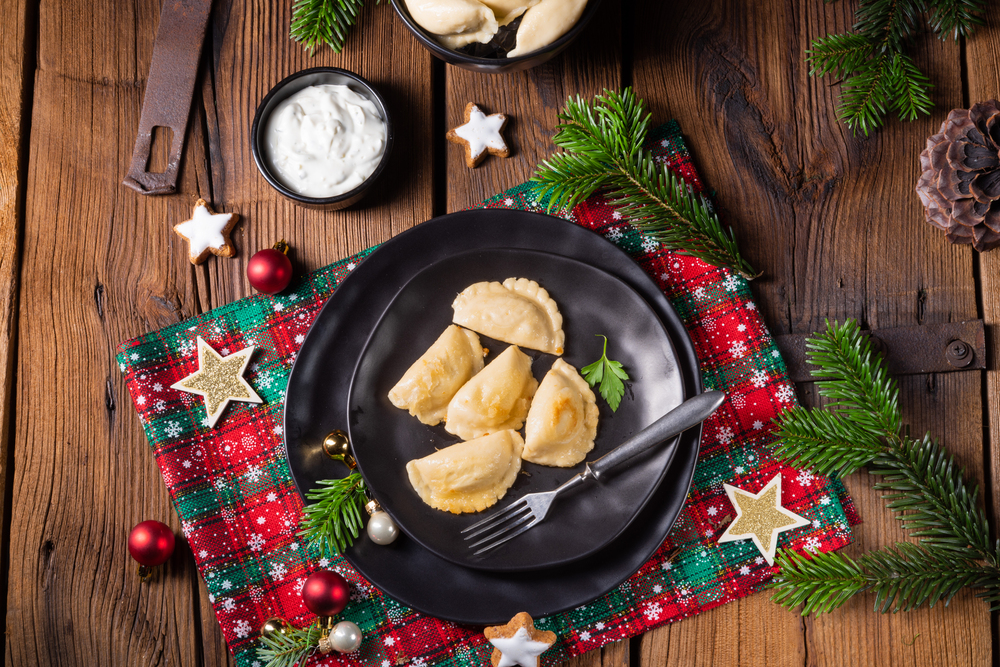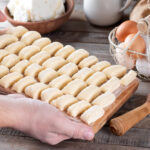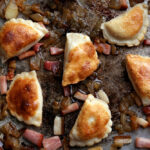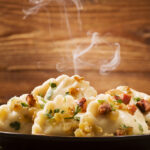Pierogi, those delectable half-moon dumplings, hold a special place in Polish cuisine and hearts. While fillings vary widely, from savory meats and cheeses to sweet fruits, mushroom pierogi stand out with their earthy flavors and versatility. Mushroom soup, another traditional dish, is especially significant during Christmas Eve dinners in Poland, highlighting the cultural importance of mushrooms in holiday feasts. This blog post explores the cultural significance of pierogi, delves into the details of mushroom pierogi, and offers a detailed, tested recipe.
What are Pierogi?
Pierogi are traditional Polish dumplings made with unleavened dough and filled with a variety of sweet or savory fillings. These delightful pockets of flavor are typically boiled and sometimes pan-fried to add a crispy texture. The singular form is “pieróg,” while the plural is “pierogi.” For centuries, pierogi have been a staple in Polish cuisine, cherished for their versatility and comforting nature.
The pierogi dough is made from simple ingredients like flour, water, eggs, and a pinch of salt. This basic dough can be rolled out thinly and cut into circles, ready to be filled with an array of ingredients. Popular fillings include potatoes, cheese, meat, mushrooms, and fruits, each offering a unique taste experience. Once filled, the pierogi are sealed and cooked, creating a delicious dish that can be enjoyed as a main course, side dish, or even dessert.
Pierogi are more than just food; they are a symbol of Polish heritage and tradition. They are often associated with family gatherings and festive occasions, bringing people together over a shared love for this comforting dish. Whether you are making them from scratch or opting for homemade pierogi from a trusted source, pierogi are sure to delight your taste buds and warm your heart.
Pierogi in Polish Culture: More Than Just Food
Pierogi are deeply connected with Polish identity and tradition. They are considered the national dish. They are a source of national pride, and a reminder of home. Many Poles associate pierogi with childhood and family gatherings. The word “pierogi” is linked to the Old Church Slavonic word for “feast.” This connection highlights their cultural importance. Pierogi were often made with leftover meat. This showed the resourcefulness of Polish cooks. Traditional fillings often include ingredients like cremini mushrooms, which are cleaned, sliced, and cooked to enhance the flavor.
Their exact origins are not certain. Pierogi are believed to have come to Poland in the 13th century. They may have arrived from the Far East via the Silk Road. Another possibility is influence from the Tatars. Pierogi are similar to other dumplings found across Eurasia. Examples include Chinese jiaozi and Italian tortellini. This shows the historical sharing of food ideas. However, Poles have made pierogi their own. They have developed countless variations. Pierogi are part of everyday meals and special events.
Pierogi are celebrated in festivals in the United States and Canada. These festivals are common in areas with large Polish American communities. Whiting, Indiana, near Chicago, and Pittsburgh, Pennsylvania, both have annual pierogi festivals.
Origin Legends of Pierogi
The history of pierogi includes interesting legends. These legends show their significance in Polish culture. One legend involves Saint Hyacinth of Poland. He is said to have brought the dish to Poland from Kyiv in the 13th century. Another legend tells of Saint Hyacinth visiting Kościelec in 1238. This was during a time of crop failure. He led the people in prayer. The crops then revived. In gratitude, the people made pierogi from the harvest.
Types of Pierogi and Regional Variations
Pierogi are adaptable. Fillings vary by region and season. This reflects the variety of Polish culinary traditions. It also depends on the availability of local ingredients. Some popular types include:
- Pierogi Ruskie: These “Russian pierogi” originated in a region that is now part of Ukraine. They are filled with potatoes, farmer’s cheese (or quark cheese), and onion. This combination is comforting and flavorful. The creamy cheese complements the starchy potatoes.
- Pierogi z mięsem: These meat-filled pierogi are another classic. They often feature pork, beef, veal, or a mix of meats. The meat is typically cooked, ground, and seasoned with herbs and spices.
- Pierogi z kapustą i grzybami: This type is filled with sauerkraut and mushrooms. It is a traditional favorite, especially during Christmas. The sauerkraut provides a tang. The mushrooms add an earthy flavor. This creates a balanced taste.
- Pierogi Lubelskie: These come from the Lublin region in southeastern Poland. They feature a filling of buckwheat, mint, bacon, and onions. This mix offers a blend of savory and herbal flavors.
- Fruit pierogi: Sweet pierogi are filled with fruits like blueberries, strawberries, or cherries. They are a delightful dessert. The fruit filling is often sweetened with sugar. It is sometimes spiced with cinnamon or other spices.
Modern Polish cuisine continues to experiment with new pierogi fillings. This shows the versatility of this dish.
Mushroom Pierogi: Earthy Flavors and Culinary Delights with Wild Mushrooms
Mushroom pierogi capture the essence of Polish forests. They have rich, earthy flavors and satisfying textures. They are usually filled with a mix of wild mushrooms. Examples are porcini, bay boletes, and parasol mushrooms. The mushrooms are often sautéed with onions. They are seasoned with herbs and spices. This creates a flavorful filling. Traditionally, uszka, small, ear-shaped mushroom pierogi, are served in borscht on Christmas Eve.
Mushroom pierogi are versatile. They can be a main course or a side dish. They are popular in autumn and winter. That is when wild mushrooms are in season. If you are looking to enjoy this Polish classic without the effort, you can easily buy pierogi online.
Making Mushroom Pierogi: A Step-by-Step Guide
Now, let’s learn how to make mushroom pierogi from scratch. This recipe combines elements from various sources. It provides a complete and authentic method.
Ingredients for the Dough:
- 3 cups all-purpose flour
- 1 large egg
- ¾ cup warm water
- 1 tablespoon sour cream
- ½ teaspoon salt
Instructions for Making the Dough:
- In a large bowl, combine the flour and salt.
- In a separate bowl, whisk together the egg and sour cream.
- Add the wet ingredients to the dry ingredients. Mix by hand or with an electric mixer on low speed. Mix until a dough forms.
- Turn the dough out onto a lightly floured surface. Knead by hand for 5-7 minutes. The dough should be smooth and not sticky. If the dough is too sticky, add flour, ½ tablespoon at a time.
- Roll the dough into a ball. Cover it with plastic wrap. Refrigerate for at least 1 hour, or up to 48 hours. This allows the gluten to relax, making it easier to roll out the dough to the proper thickness before cutting it into circles.
Ingredients for the Mushroom Filling:
- 1 pound assorted mushrooms (such as cremini, shiitake, or oyster)
- ½ tablespoon butter
- ½ tablespoon olive oil
- ¼ cup minced shallots
- 2 tablespoons lemon juice
- 1 teaspoon salt
- ¼ teaspoon freshly ground black pepper
- 1 teaspoon fresh thyme
- 3 tablespoons heavy cream
- 1 tablespoon minced flat-leaf parsley
Instructions for Making the Mushroom Filling:
- If using shiitake mushrooms, remove the stems. Trim the stems of other mushrooms as needed.
- Place the mushrooms in a food processor. Pulse about eight times, until finely chopped. Do not over-process. You want to keep some texture.
- In a medium sauté pan, melt the butter and oil over low heat. Add the shallots. Cook, covered, until softened. This takes about 2 minutes.
- Add the mushrooms, lemon juice, salt, and pepper to the pan. Mix well.
- Raise the heat to medium. Cook, stirring occasionally. Continue until the mixture is nearly dry. This takes about 8 to 10 minutes. This allows the mushrooms to release moisture. It develops a deeper flavor.
- Add the cream, thyme, and parsley. Cook for about 1 minute more. The cream adds richness. It helps bind the filling.
- Transfer the filling to a bowl. Let it cool completely before assembling the pierogi.
Instructions for Assembling and Cooking the Pierogi:
- On a lightly floured surface, roll out the chilled dough. Roll it to a thickness of about ⅛ inch.
- Use a 3-inch round cutter or a glass. Cut out circles from the dough. Gather the scraps. Re-roll them. Cut out more circles. Continue until all the dough is used.
- Place a heaping teaspoon of the cooled mushroom filling in the center of each circle.
- Moisten the edges of the dough with water. Fold the circle in half. Form a semicircle. Pinch the edges closed to seal in the filling. Use your fingers or a fork to crimp the edges. This creates a decorative touch.
- Place the assembled pierogi on a lightly floured baking sheet. This prevents sticking.
- Bring a large pot of salted water to a boil.
- Gently add the pierogi to the boiling water in batches. Do not overcrowd the pot. Overcrowding can cause the pierogi to stick together. It can also cause uneven cooking.
- Cook the pierogi until they float to the surface. This takes about 2 minutes. Then continue cooking for another 3 to 4 minutes. This ensures the dough is cooked. It also heats the filling.
- Remove the pierogi with a slotted spoon. Drain them well. Place them on a clean kitchen towel. This absorbs extra moisture.
- For a crispy texture, pan-fry the boiled pierogi in butter. Fry until golden brown.
- Alternatively, steam the pierogi for about 10 minutes instead of boiling.
Variations on the Mushroom Pierogi Recipe
While the traditional mushroom pierogi recipe is a beloved classic, there are numerous variations you can explore to suit different tastes and preferences. Here are some ideas to inspire your culinary creativity:
- Different Types of Mushrooms: Experiment with various mushrooms like cremini, shiitake, or oyster mushrooms to create a unique flavor profile. Each type of mushroom brings its own distinct taste and texture to the filling.
- Additional Ingredients: Enhance the mushroom filling by adding ingredients such as sauerkraut, onions, or garlic. These additions can add depth and complexity to the flavor, making each bite more interesting.
- Alternative Doughs: Try using different types of dough, such as pasta dough or pastry dough, to create a different texture and flavor. Pasta dough can give a more delicate texture, while pastry dough can add a flaky, buttery element.
- Creamy Additions: For a richer and creamier filling, consider adding a splash of cream or sour cream. This can elevate the mushroom filling, making it even more indulgent.
- Fresh vs. Dried Mushrooms: Using fresh mushrooms instead of dried mushrooms can result in a brighter and more vibrant flavor. Fresh mushrooms tend to have a more delicate taste, while dried mushrooms offer a more concentrated, earthy flavor.
By experimenting with these variations, you can create a mushroom pierogi recipe that is uniquely your own. Whether you stick to the traditional method or try something new, the result is sure to be delicious.
Serving Suggestions for Mushroom Pierogi with Sour Cream
Mushroom pierogi can be served in many ways. Some popular options include:
- With melted butter and onions: This is a simple, classic method. It allows the mushroom flavors to shine. Sauté onions in butter until golden brown. Pour them over the pierogi.
- With sour cream: Sour cream’s tang complements the mushroom filling. Add a dollop of sour cream to each serving.
- With caramelized onions: Caramelized onions add sweetness. Slowly cook sliced onions in butter. Cook until they are soft, brown, and caramelized.
- With skwarki (fried pork fatback): For a traditional touch, sprinkle crispy skwarki over the pierogi.
- With a mushroom sauce: A creamy mushroom sauce enhances the mushroom flavor. It adds indulgence. Find mushroom sauce recipes online or in cookbooks.
Tips and Tricks for Perfect Mushroom Pierogi
Dough Tips
- Use hot water: Hot water makes the dough softer. It becomes more pliable. This is important for rolling it out thinly.
- Knead the dough well: Kneading develops the gluten. This gives the dough elasticity. It prevents tearing.
- Let the dough rest: Resting the dough relaxes the gluten. This makes it easier to roll out. It is less likely to shrink back.
Filling Tips
- Use a variety of mushrooms: Combining different mushrooms adds depth and complexity to the filling.
- Don’t overcook the mushrooms: Overcooked mushrooms can become rubbery. Sauté until tender, but with some texture.
- Season the filling well: Use salt and pepper generously. This enhances the mushroom flavors.
Assembly and Cooking Tips
- Seal the edges tightly: Ensure the pierogi edges are well-sealed. This prevents the filling from leaking.
- Don’t overcrowd the pot: Cook the pierogi in batches. This ensures even cooking.
Common Mistakes to Avoid
Making pierogi can be a rewarding experience, but there are several common mistakes that can affect the final result. Here are some tips to help you avoid these pitfalls and ensure your pierogi turn out perfect every time:
- Overworking the Dough: Kneading the dough too much can make it tough and dense. Aim for a smooth, elastic dough that is not overworked. This will ensure a tender and pliable pierogi dough.
- Undercooking the Pierogi: Not cooking the pierogi long enough can result in a raw or undercooked filling. Make sure to cook them until they float to the surface and then continue cooking for a few more minutes to ensure the filling is heated through.
- Using the Wrong Flour: The type of flour you use can affect the texture and flavor of the dough. All-purpose flour is typically recommended for pierogi dough, as it provides the right balance of strength and tenderness.
- Insufficient Seasoning: A bland filling can make the pierogi uninteresting. Be generous with salt and pepper, and taste the filling before assembling the pierogi to ensure it is well-seasoned.
- Improper Storage: Storing pierogi improperly can cause them to stick together or become soggy. If you need to store them, place them in a single layer on a baking sheet and freeze them before transferring to a storage container. This prevents them from sticking together.
By keeping these tips in mind and following a tried-and-true pierogi recipe, you can create delicious and authentic pierogi that will impress your family and friends. Enjoy the process and savor the results!
Conclusion
Mushroom pierogi embody Polish culinary heritage. They began as peasant food. They are now a national symbol. Pierogi have played a big role in Polish culture and cuisine. The variety of fillings shows the adaptability of pierogi. These fillings reflect regional variations and seasonal ingredients. Mushroom pierogi, with their earthy flavors, are a delicious example. They showcase culinary versatility.
By following this recipe and the tips, you can make your own pierogi. Experience the joy of creating this Polish classic. Enjoy them with melted butter, sour cream, or mushroom sauce. Mushroom pierogi will delight your taste buds. They will transport you to the heart of Polish cuisine. Gather your ingredients. Put on your apron. Get ready to savor homemade mushroom pierogi! You can also explore options to buy pierogi online for convenience.








